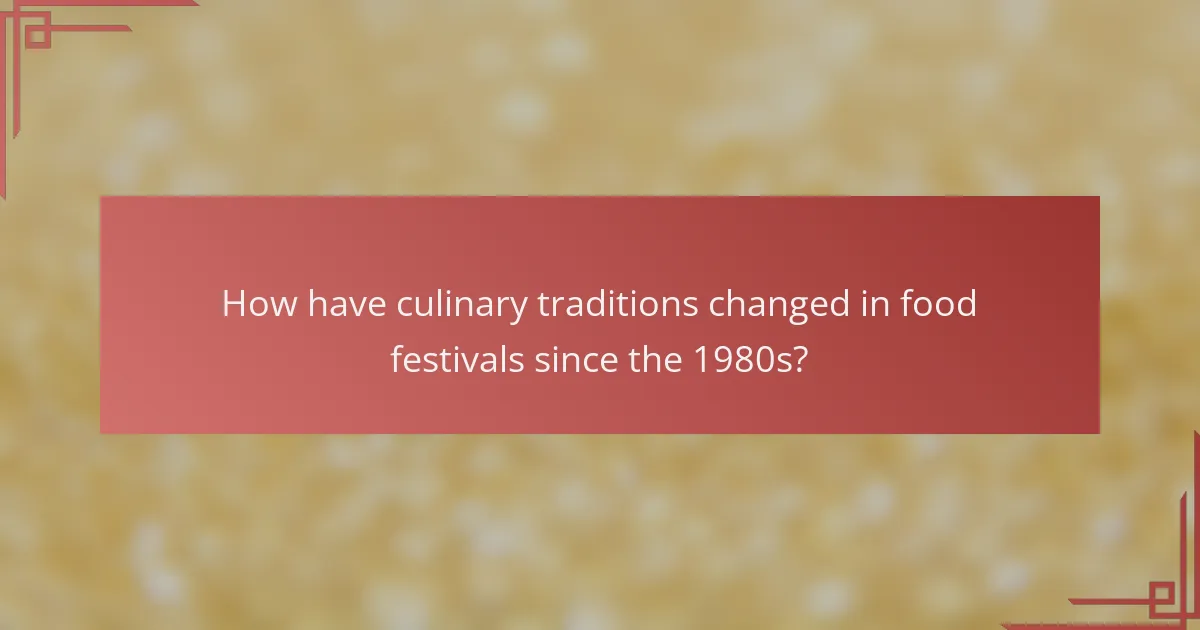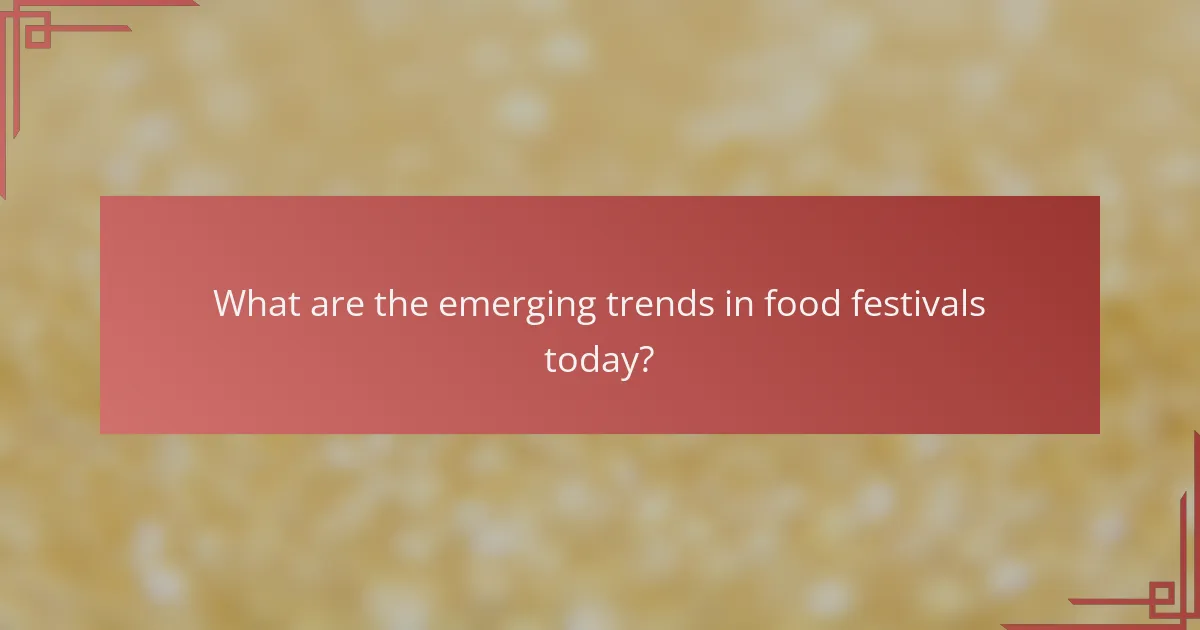The evolution of culinary traditions in food festivals over the decades reflects significant societal changes and increased cultural exchange. From the 1980s to today, these festivals have transformed into vibrant celebrations of global cuisines, innovative fusion dishes, and a strong focus on sustainability and local sourcing. Influenced by cultural exchange, social media, and celebrity chefs, food festivals now offer diverse and accessible experiences that highlight regional identities and foster community pride.

How have culinary traditions changed in food festivals since the 1980s?
Culinary traditions in food festivals have evolved significantly since the 1980s, reflecting broader societal changes and increased cultural exchange. Today, food festivals showcase a diverse array of global cuisines, innovative fusion dishes, and a strong emphasis on sustainability and local sourcing.
Increased globalization of cuisines
The globalization of cuisines has transformed food festivals into vibrant showcases of international flavors. Attendees can now experience dishes from various cultures, often prepared by chefs who blend traditional techniques with modern culinary practices.
For example, a festival in the United States may feature Thai street food alongside Italian pasta, highlighting the growing acceptance and popularity of diverse culinary traditions. This trend encourages cultural exchange and fosters appreciation for global cuisines.
Rise of fusion food trends
Fusion food trends have gained traction at food festivals, where chefs creatively combine elements from different culinary traditions. This approach results in unique dishes that appeal to adventurous eaters looking for novel flavors.
Examples include Korean tacos or sushi burritos, which merge distinct cultural ingredients and cooking styles. While fusion cuisine can be exciting, it’s essential for chefs to maintain balance and respect for the original dishes to avoid diluting their authenticity.
Emphasis on local ingredients
There is a growing emphasis on local ingredients at food festivals, driven by consumer demand for fresh, sustainable food. Many festivals now prioritize farm-to-table practices, showcasing dishes made with locally sourced produce and meats.
This trend not only supports local farmers but also enhances the flavor and quality of the food served. Attendees are increasingly interested in knowing where their food comes from, making local sourcing a key selling point for festival organizers.
Adoption of sustainable practices
Sustainable practices have become a cornerstone of food festivals, reflecting a broader commitment to environmental responsibility. Many festivals are implementing measures to reduce waste, such as using compostable utensils and encouraging recycling.
Additionally, some festivals are featuring educational components that inform attendees about sustainable food practices, such as the benefits of organic farming and reducing food miles. This shift not only enhances the festival experience but also promotes a culture of sustainability within the culinary community.

What are the key influences on food festival evolution?
The evolution of food festivals has been significantly shaped by various influences, including cultural exchange, social media, and the rise of celebrity chefs. These factors have transformed how food is presented and celebrated, making festivals more diverse and accessible to a wider audience.
Cultural exchange through travel
Cultural exchange through travel has played a pivotal role in the evolution of food festivals. As people explore different regions, they bring back culinary traditions and flavors that enrich local festivals. This exchange fosters a blending of cuisines, creating unique dishes that reflect a fusion of cultural influences.
For example, Mediterranean food festivals often showcase a mix of Italian, Greek, and Middle Eastern dishes, highlighting the interconnectedness of these culinary traditions. Travelers’ experiences can inspire festival organizers to incorporate diverse food offerings, attracting a broader audience.
Impact of social media on food trends
Social media has dramatically influenced food trends and, consequently, food festivals. Platforms like Instagram and TikTok allow chefs and food enthusiasts to share visually appealing dishes, creating viral trends that festivals often adopt. This rapid dissemination of ideas encourages innovation and experimentation in festival menus.
Festivals now feature Instagrammable food items, such as colorful desserts or unique food pairings, to attract attendees. Organizers should consider leveraging social media for marketing and engagement, ensuring their festival remains relevant and appealing to younger audiences.
Celebrity chefs shaping festival offerings
Celebrity chefs have become key figures in shaping food festival offerings, often bringing their unique culinary styles to the forefront. Their involvement can elevate a festival’s profile, drawing in crowds eager to experience their signature dishes. Festivals featuring renowned chefs often see increased attendance and media coverage.
For instance, a food festival that includes cooking demonstrations or tastings by a popular chef can create a buzz, encouraging food lovers to participate. Organizers should consider collaborating with local culinary stars to enhance their festival’s appeal and authenticity.

How do food festivals reflect regional culinary identities?
Food festivals serve as vibrant showcases of regional culinary identities, highlighting local ingredients, traditional dishes, and cultural heritage. They create a platform for communities to celebrate their unique flavors and cooking styles, fostering a sense of pride and connection among participants and visitors.
Showcasing local specialties
Food festivals prominently feature local specialties that define a region’s culinary landscape. For instance, a festival in Italy might highlight regional pasta dishes, while a festival in Mexico could celebrate traditional tacos made with locally sourced ingredients. This focus not only promotes local agriculture but also educates attendees about the distinct flavors and techniques that characterize the area.
Visitors often have the opportunity to taste a variety of dishes, encouraging them to explore and appreciate the diversity of local cuisine. Engaging with local chefs and producers at these events can deepen understanding of the ingredients and methods that make each dish special.
Highlighting traditional cooking methods
Many food festivals emphasize traditional cooking methods that have been passed down through generations. Techniques such as wood-fired cooking, fermentation, and artisanal baking are often demonstrated, allowing attendees to witness the craftsmanship involved. For example, a barbecue festival in the southern United States may showcase slow-cooking methods that enhance flavor and tenderness.
These demonstrations not only preserve culinary traditions but also inspire attendees to try these methods at home. Understanding the history and significance behind these techniques can enrich the overall festival experience.
Community involvement in festival planning
Community involvement is a crucial aspect of food festivals, as local residents often play a key role in planning and executing the events. This collaboration fosters a sense of ownership and pride, as community members contribute their knowledge and skills to create an authentic experience. For example, local chefs may collaborate with farmers to curate menus that reflect seasonal produce.
Moreover, engaging the community in festival planning can lead to a more diverse representation of culinary traditions, ensuring that various voices and stories are included. This inclusivity enhances the festival’s appeal and strengthens community bonds, making the event a true celebration of regional identity.

What role do food festivals play in promoting tourism?
Food festivals play a significant role in promoting tourism by attracting visitors to local areas, showcasing regional cuisines, and enhancing cultural engagement. These events create a vibrant atmosphere that encourages both locals and tourists to explore the culinary diversity of a region.
Attracting visitors to local economies
Food festivals draw large crowds, which directly benefits local economies. Visitors often spend money on accommodations, dining, and shopping, providing a boost to small businesses and creating job opportunities. For instance, a well-attended festival can increase hotel bookings by a substantial percentage, especially in smaller towns.
To maximize economic impact, festival organizers should consider collaborating with local businesses to offer packages that include lodging and dining options. This approach not only enhances visitor experience but also ensures that the economic benefits are widely distributed across the community.
Creating unique cultural experiences
Food festivals offer unique cultural experiences that highlight local traditions and culinary practices. They often feature cooking demonstrations, tastings, and cultural performances that immerse attendees in the region’s heritage. This engagement fosters a deeper appreciation for local customs and flavors.
Organizers can enhance these experiences by incorporating interactive elements, such as workshops where participants can learn to cook traditional dishes. This not only entertains but also educates visitors, making their experience more memorable and meaningful.
Enhancing regional visibility
Food festivals significantly enhance regional visibility by showcasing local cuisine to a broader audience. They serve as a platform for local chefs and food artisans to gain recognition, which can lead to increased media coverage and tourism interest. A successful festival can position a region as a culinary destination.
To further boost visibility, festival organizers should leverage social media and partnerships with travel influencers. Engaging content and strategic promotions can attract attention and encourage visitors to share their experiences, amplifying the festival’s reach beyond the immediate area.

How do food festivals adapt to changing consumer preferences?
Food festivals adapt to changing consumer preferences by incorporating diverse offerings that reflect current dietary trends and values. This includes a shift towards plant-based options, health-conscious choices, and accommodations for various dietary restrictions.
Incorporation of plant-based options
Many food festivals now feature a variety of plant-based dishes to cater to the growing demand for vegetarian and vegan options. This shift is driven by increased awareness of health benefits and environmental concerns associated with meat consumption.
For example, festivals may include plant-based versions of traditional dishes, such as vegan tacos or jackfruit pulled “pork.” Offering these alternatives not only attracts a broader audience but also aligns with sustainability goals.
Focus on health-conscious offerings
Health-conscious offerings at food festivals are becoming more prevalent as consumers prioritize nutrition. This includes options that are low in sugar, gluten-free, or rich in whole foods.
Festivals may highlight dishes that use organic ingredients or feature superfoods like quinoa and kale. Providing clear nutritional information can help attendees make informed choices and enhance their overall experience.
Embracing dietary restrictions
Food festivals increasingly embrace dietary restrictions by offering gluten-free, nut-free, and allergen-friendly options. This inclusivity ensures that all attendees can enjoy the festival without health concerns.
Organizers can implement clear labeling and staff training to address these needs effectively. For instance, having a designated area for allergen-free foods can help prevent cross-contamination and provide peace of mind for those with specific dietary requirements.

What are the emerging trends in food festivals today?
Emerging trends in food festivals today focus on sustainability, diverse culinary offerings, and enhanced visitor experiences through technology. These trends reflect a growing consumer interest in environmental responsibility and unique gastronomic adventures.
Integration of technology in experiences
Technology is increasingly integrated into food festival experiences, enhancing engagement and convenience for attendees. Mobile apps for event navigation, online ticketing, and real-time updates on food availability are now common features.
Additionally, augmented reality (AR) and virtual reality (VR) are being used to create immersive experiences. For example, some festivals offer VR tours of food production processes or AR menus that provide detailed information about dishes and ingredients.
When planning to attend or organize a food festival, consider leveraging technology to improve visitor interaction. Ensure that your event has a user-friendly app or website, and explore innovative tech solutions to elevate the overall experience.



